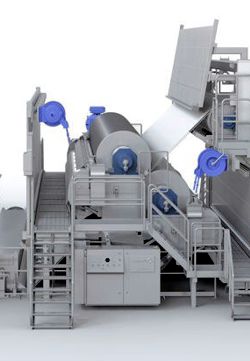Helpful tips for size pressing: properties, load, vibration…
Jan 18, 2022

Higher base paper porosity and roughness increase size penetration.
Higher size solids and viscosity increase the size pickup. Cationic size pickup better than anionic starches. Typical size viscosities are 25-40 cp at 100 rpm.
Edge wipe material: PUR 70 SH (RAU4500475)
The maximum speed of puddle size presses is 3100 fpm (leads to higher forces in the nip and wetter weaker sheet after the sizer).
The maximum air content of starch is 5% by volume as measured by a high precision pycnometer.
In a conventional puddle size press at high speeds, the pond becomes unstable and there is size rejection at the nip, causing uneven pickup of wet film. The critical roll speed where nip rejection occurs is inversely proportional to viscosity.
Starch pickup affected by these variables, normally limited to 20% of the basesheet weight:
- basepaper properties - pickup decreases with lower absorbency, lower sheet porosity, higher internal sizing, **lower moisture content**
- coating properties - pickup decreases with lower viscosity (but is needed to run at higher speeds), solids, temperature
- equipment setup variables - speed, pond depth, nip pressure, width
High solids coating pickup without film patterns is dependent on coating rheology higher shear thinning capacity
Nip loading sequence
- After pressing the Load button, the pressure controllers are forced on at constant pressure.
- Crossover valves open between both cylinders, evening out pressure on both sides. Closing speeds are set with flow control valves.
- Closing of the nip is sensed by a proximity switch.
- There is a short delay before closing the crossover valve.
- There is a short delay to allow pressures to stabilize at previous targets.
- Loading pressure regulators switch to automatic mode.
Size press roll information
Desired properties: abrasion resistance, thickness, hardness, nip width and pressure, heat accumulation effects, marking resistance, rebound and resiliency, smoothness (<1.8 um Ra for starch, <0.8 um Ra coatings).
Dynamic properties: thermal changes, swelling effects, chemical effects.
Vibration: transmissibility, temperature effects, frequency effects.
Surface characteristics: smoothness, wettability, film splitting, coat transfer, material effects, swelling effects.
New coating applications use softer rolls due to lower nip pressures, improved runnability, higher coat weights, surface location of coating and moderate dewatering.
High performance rubber covers are made of chlorosulfonated polyethylene (CSM) or hydroginated nitrile rubber (HNBR).
High roll temperature, especially on starch grades, requires roll cooling to keep temperatures low.
Polyurethane helps dampen vibration more and wears better than rubber covers.
Roll crowns are normally ground using a cosine70 target. For nips with quarter point issues, can use a cosine90 grind target.
Vibration in film size presses
Can be caused by: worn/damaged bearings, drive system, rod and roll, rod and bed, stick/slip between rolls, natural vibration frequency close to applicator roll frequency, cover Young's modulus effects.
Cover thickness affects natural frequency (smaller thickness = higher natural frequency).
Rolls which have banding cause vibration, but gradually return to being round after the nip opens up.
Higher roll shell thickness deceases frequency.
For more information on size press operations, contact your Valmet representative.